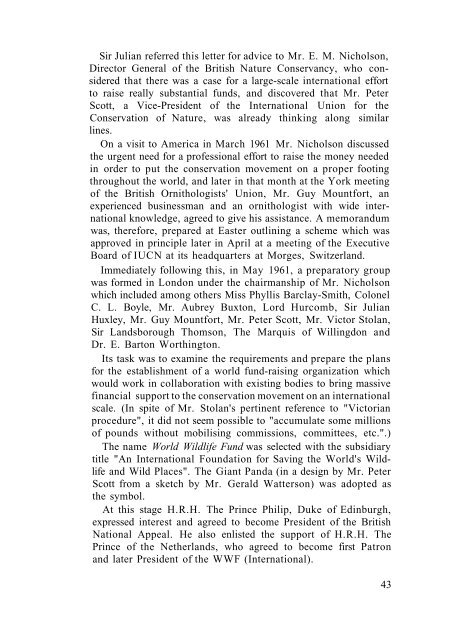1973 iucn yearbook
1973 iucn yearbook
1973 iucn yearbook
You also want an ePaper? Increase the reach of your titles
YUMPU automatically turns print PDFs into web optimized ePapers that Google loves.
Sir Julian referred this letter for advice to Mr. E. M. Nicholson,<br />
Director General of the British Nature Conservancy, who considered<br />
that there was a case for a large-scale international effort<br />
to raise really substantial funds, and discovered that Mr. Peter<br />
Scott, a Vice-President of the International Union for the<br />
Conservation of Nature, was already thinking along similar<br />
lines.<br />
On a visit to America in March 1961 Mr. Nicholson discussed<br />
the urgent need for a professional effort to raise the money needed<br />
in order to put the conservation movement on a proper footing<br />
throughout the world, and later in that month at the York meeting<br />
of the British Ornithologists' Union, Mr. Guy Mountfort, an<br />
experienced businessman and an ornithologist with wide international<br />
knowledge, agreed to give his assistance. A memorandum<br />
was, therefore, prepared at Easter outlining a scheme which was<br />
approved in principle later in April at a meeting of the Executive<br />
Board of IUCN at its headquarters at Morges, Switzerland.<br />
Immediately following this, in May 1961, a preparatory group<br />
was formed in London under the chairmanship of Mr. Nicholson<br />
which included among others Miss Phyllis Barclay-Smith, Colonel<br />
C. L. Boyle, Mr. Aubrey Buxton, Lord Hurcomb, Sir Julian<br />
Huxley, Mr. Guy Mountfort, Mr. Peter Scott, Mr. Victor Stolan,<br />
Sir Landsborough Thomson, The Marquis of Willingdon and<br />
Dr. E. Barton Worthington.<br />
Its task was to examine the requirements and prepare the plans<br />
for the establishment of a world fund-raising organization which<br />
would work in collaboration with existing bodies to bring massive<br />
financial support to the conservation movement on an international<br />
scale. (In spite of Mr. Stolan's pertinent reference to "Victorian<br />
procedure", it did not seem possible to "accumulate some millions<br />
of pounds without mobilising commissions, committees, etc.".)<br />
The name World Wildlife Fund was selected with the subsidiary<br />
title "An International Foundation for Saving the World's Wildlife<br />
and Wild Places". The Giant Panda (in a design by Mr. Peter<br />
Scott from a sketch by Mr. Gerald Watterson) was adopted as<br />
the symbol.<br />
At this stage H.R.H. The Prince Philip, Duke of Edinburgh,<br />
expressed interest and agreed to become President of the British<br />
National Appeal. He also enlisted the support of H.R.H. The<br />
Prince of the Netherlands, who agreed to become first Patron<br />
and later President of the WWF (International).<br />
43

















